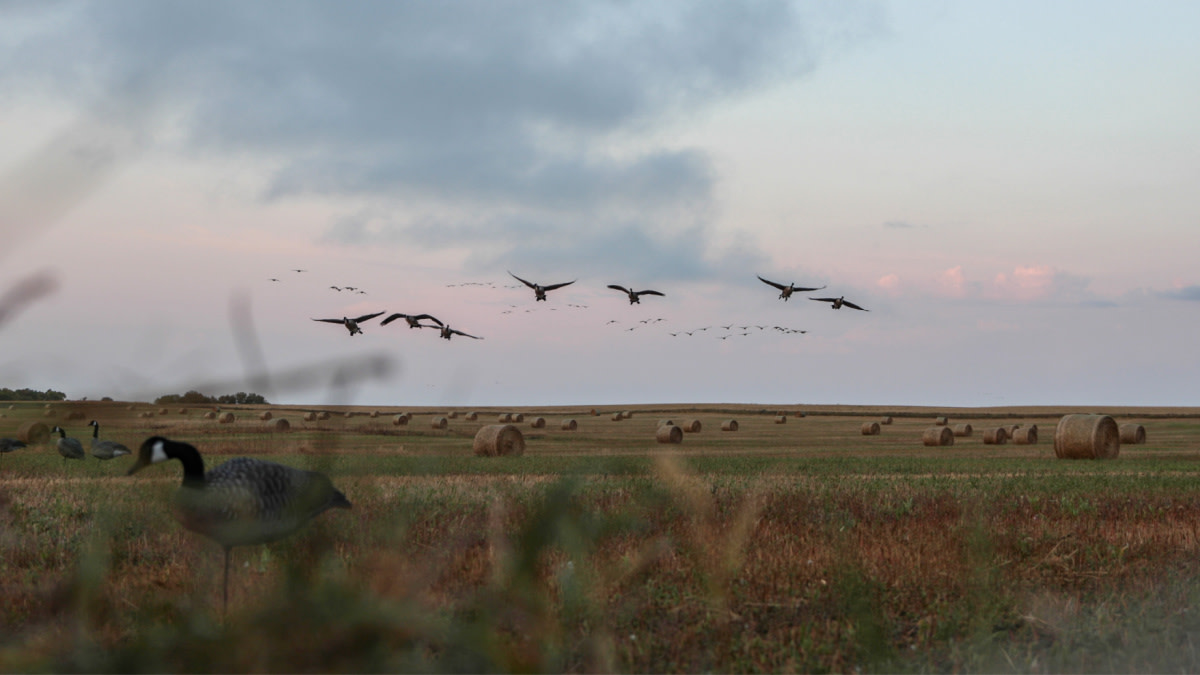
Every summer, waterfowl across North America have to figure out where they’ll go to molt. The where, why, and who have been misunderstood by hunters for years, but knowing how the molt migration works is valuable and important.
What is the Molt Migration? Every year, geese (and all waterfowl) lose their feathers, and grow back new ones. It’s physically taxing, and requires the birds to go flightless for 3 to 4 weeks when they shed their primary feathers. Because the molt is such a demanding process, many of the birds will fly a long ways to find the ideal location.
According to Dr. Chris Nicolai, Waterfowl Scientist at Delta Waterfowl, the molt is about resources.
“The molt migration is what geese have to do to free up space and resources when they are unable to breed where they’re from,” Nicolai said. “These big city geese in the lower latitudes don’t breed until they’re 4 years old. As a gosling, they get a freebie and are allowed in the park (by the breeders) but if they can’t breed, they have to leave. And the breeding birds with failed nests will also go on a molt migration.”
The geese with young, however, stay put for the molt.
“Successful breeders with young will go through their molting process on their breeding grounds,” Nicolai said. “In the lower latitudes, these are the local geese you see all summer on your local lakes, golf courses, and city parks. And unlike ducks, they’ll actually go flightless while still rearing young.”
Where Do They Migrate To? Which flyway you’re in largely dictates where your birds go and because the molt is about resources, these birds go to where they can find lots of nutrition.
“We have big geese nesting everywhere from San Francisco to New York. The western geese will get to the edge of the boreal and molt there. They don’t go super far north,” Nicolai said. “But as you move east, lower latitude geese go way north. We will be in helicopters in the Arctic looking for cacklers to band and we’ll land, set up the net, and then realize they’re molting Giants. The whole shore of Hudson Bay calls to them in the summer.”
And it seems the reason for the long northern migration is fast-growing food.
“They pick their high-latitude locations probably based on food. Up north, the food is superior in the summer, because the sun is out almost all 24 hours of the day. Those northern plants only get 2 to 3 months to grow, so they grow like crazy. For a goose, it’s a nitrogen-filled candy bar. The geese are taking advantage of that,” Nicolai said.
The Misconception About Molt Migrators In recent years, more and more hunters have talked about the molt migration. The commonly spread belief is that every September, the molt migrators begin their return from the north, and the northern states like Minnesota and Wisconsin see great hunting as a result.
But according to Dr. Nicolai, the September molt migration is just not true. While there’s plenty of truth to the good goose hunting each September, it’s not the molts that head north during the summer.
“In the August and September season, we’re shooting breeders and new goslings,” said Nicolai. “The management strategy is to shoot these lower latitude breeding geese before the molt migrants and arctic geese show back up. The molt migrants aren’t back yet in September, they actually spent the summer with cacklers and snows, and return at the same time as them.”
Hunting September Migrators Even though the birds seen every September aren’t the molt migrators, there still are geese moving around with the cooler temperatures. It’s common for the breeders and their young to make short regional migrations, and these account for the fresh birds that hunters see arrive in their area each September. According to Dr. Nicolai, the earliest molt migrators return in the northern states is late September.
But hunters can still take advantage of the September movement.
While hunting feeds is still a working strategy in September, more and more hunters are turning to migration patterns, even in September. Zach Johnson, a goose hunter from northern Minnesota, has success with this every year.
“If you are anywhere from North Dakota to Michigan, get in a field where the decoys really pop,” Johnson said. “The biggest thing is visibility, be somewhere they can see you from a long way. And use as many decoys as you can get ahold of; homemade, silos, shells or full bodies. Just get as many as possible.”
But once the birds see you, you have to keep their attention.
“You need to make it seem like it’s worth the stop, so call as loud and aggressive as you can. If you can breathe, there should be a call in your hand. Lots of noise is great, lots of great noise is best,” Johnson said. “My favorite part is making those geese do something they didn’t want to do when they woke up that morning.”
Even though they’re not necessarily molt migrators, bird movements associated with September cold fronts provide lots of opportunity to start the waterfowl season right.






Conversation